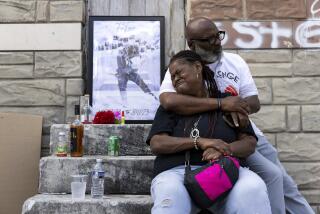A Sad Tale of Persecuted Minorities : Racism: Slaying of a South-Central teen-ager underscores the disturbing economics of being Koreans and African-Americans.
Latasha Harlins, a 15-year-old African-American school girl, is dead from a gunshot wound to the head after trying to buy orange juice in a South-Central convenience store. A 51-year-old Korean-American businesswoman, Soon Ja Du, is in jail for allegedly pulling the trigger. But we can’t count all the victims in this American tragedy.
Harlins, clearly, is a victim. Du is both victimizer and victim. Their families and communities are victimized by grief, with the need to mitigate the damage to the relationships between Korean-Americans and African-Americans.
The 20th Century is marked by the urbanization of African-Americans. Structural inequality, exacerbated by residential segregation, has resulted in communities that were and remain hard put to secure the most basic economic goods and services. This economic impotence of the African-American community opens the way for non-African-American entrepreneurs to fill the commerce vacuum, typically at a price that includes the added costs of doing business in economically depressed areas.
Today, those immigrant merchants are overwhelmingly Korean. In South-Central, a majority of the convenience stores are owned and operated by Korean-American families. The situation in New York City and in other metropolitan areas is similar.
This economic fact underscores the lack of opportunities immigrant Koreans have in America. They continually face discrimination in education and employment. Entrepreneurship offers them a reliable route to economic success.
African-Americans, on the other hand, have virtually no meaningful opportunity to take control of their community’s economy. Lack of education and training, as well as employment discrimination, block their economic empowerment. Their economic peril is historically ingrained and appears intractable.
The ethnic diversification of America necessarily carries with it many dangers. In particular, the confluence of African-American and Korean-American cultures invites conflicts in language, behavioral styles, customs, ideologies and values.
Of course, Korean merchants, like any others, face conflicts with customers, competitors and workers. But when clients and merchants are members of groups who each have long and bitter experiences of racial and ethnic discrimination, the simple act of buying orange juice, as in Latasha Harlins’ case, can became an occasion for violence.
Several Korean merchants have been killed in the Los Angeles area. It is thus easy to understand why they arm themselves for self-defense. Latasha Harlins may be the first customer to be killed in a store owned by Koreans. It is unlikely that she will be the last. Guns, in America, have increasingly become the final arbiters of such interpersonal and intergroup disputes.
The media contribute to the potential for conflict by latching on to images that degrade African-Americans and Asian-Americans. When a group of people are routinely dehumanized in the popular culture, as African-Americans are, it is not surprising to see them as frequent victims of nightsticks and guns. A disturbing and enduring lack of fundamental respect for African-Americans connects the beating of Rodney G. King by the LAPD and the murder of Latasha Harlins. African-Americans are the most vulnerable--and victimized--group in our society.
But understanding these issues--of structured inequality, of racism, of media prejudice, of cultures in conflict--does not make solutions any easier to identify. Clearly, racism must be eliminated, equal opportunity implemented and upheld, sensitivity to different peoples and cultures stressed.
We need to translate these broad initiatives, however, into individual practices that reduce prejudice, intolerance and the potential for violent conflict. At some point, we need to resocialize ourselves in a way that views the use of lethal force as a method of no resort.
Recently, the Black/Korean Alliance in Los Angeles held a breakfast meeting on the steps of City Hall. Established to mediate conflicts between Korean merchants and their African-American customers, the group of business, religious and community leaders has been successful in avoiding the acrimonious boycotts that characterize Black/Korean relationships in New York City. Last year, the alliance succeeded in getting Korean merchants and their protesting customers to talk to each other, thus defusing a potential confrontation. Currently, it is facilitating the formation of joint economic ventures, religious and cultural exchange programs and developing a political agenda. The group now must contend with renewed animosity in the wake of Latasha Harlins’ slaying.
That will not be easy. A group of African-American and Asian-American researchers at UCLA recently drafted a proposal to study the nature and causes of conflicts between African-Americans and Korean-Americans in Los Angeles. They also seek to develop guidelines on how to resolve them. Their challenge is that social-science theory in the area of minority-minority conflict is almost nonexistent, and new research methodologies need to be developed if meaningful data are to be collected.
Tragedy is certainly not a new theme in America’s interracial relationships. If there is anything to be gained from such tragedies as the slaying of Latasha Harlins, they include the increased sensitivity that we are forced to develop toward one another, the need to grapple with differences in cultures, the incentive for non-violent means to resolve conflicts and recognition that basic features of our society set the stage for inter-ethnic conflict and violence.
More to Read
Inside the business of entertainment
The Wide Shot brings you news, analysis and insights on everything from streaming wars to production — and what it all means for the future.
You may occasionally receive promotional content from the Los Angeles Times.










